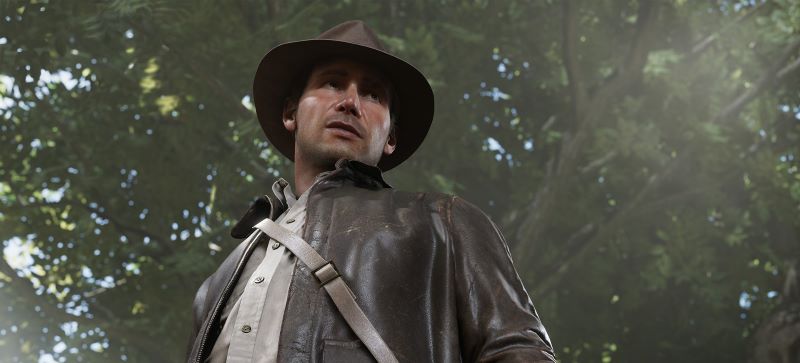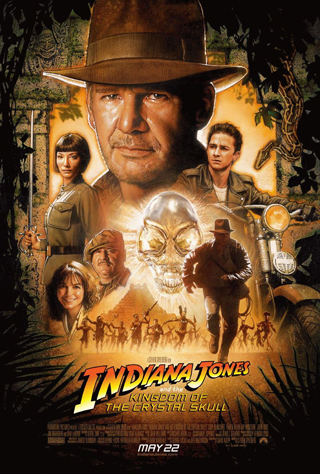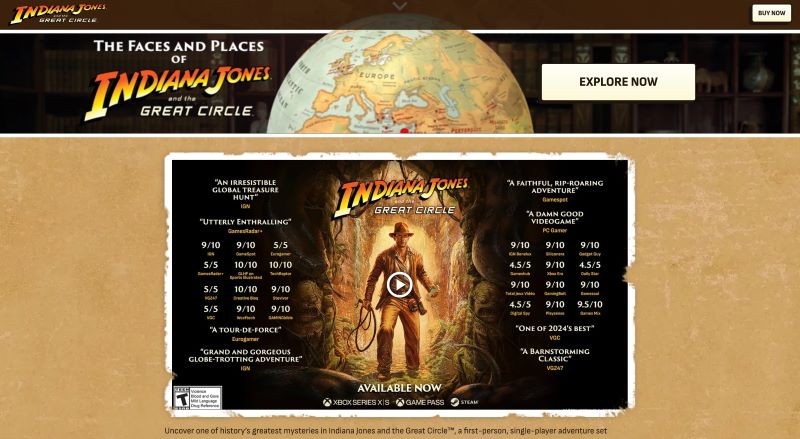A major video game built around the “Indiana Jones” movies aims to cash in as licensed merchandise and keep the film franchise alive in hearts of consumers.
Video game “Indiana Jones and the Great Circle” is from Bethesda MachineGames, which is owned by Xbox maker Microsoft. It’s built on the film legacy of the five Indy Jones adventure motion pictures distributed by Paramount Pictures. The core intellectual property rights are owned by Walt Disney Co., after buying filmmaker George Lucas’ content company Lucasfilm in 2012 for $4 billion.
Its consumer-facing website (pictured above) is an elaborate and attractive anchor for marketing, chocked full of content accumulated after the video game was developed over five years. With lively still images, the website presents game reviews by third parties, video segments (including a 14 minute, 30 second “deep dive”), bits of plot (“whip-cracking action”), fleshes out characters both good guys and villains, explains game play (“you are Indiana Jones”), and purchase information.

“The ‘Great Circle’ at the center of … the game is a collection of sites around the world that mysteriously form a perfect circle when connected together on a map,” says an article by Jennifer Maas in trade newspaper Variety. True to its 1930s setting, the game serves up diabolical Nazis, flying Zeppelins and period-correct world events as backdrops. It’s a first-person, single-player game with state-of-the-art life-like video images.
Released Dec. 9, “Great Circle” costs about $70 retail and there’s a $100 premium version. Its audience-suitability classification is “Teens-Blood and Gore, Drug Reference, Mild Language, Violence”; the theatricals are mostly rated PG-13, which is comparable.
While originally conceived as an Xbox format exclusive, “Great Circle” was released in three formats for the Xbox, Playstation and personal computer platforms. The 82-year-old Harrison Ford, star of the movies, did not voice the video game.

Reviews from independent critics are favorable and many are on the website. “This game can be a bit wonky,” writes Ted Lichfield in PC Gamer, “but the overall experience, the immersion, atmosphere, and sense of fun are greater than the sum of its parts. The magic and believability of MachineGames’ vision of the 1930s and ‘The Great Circle’s’ fantastic storytelling carrying the day.” The review praises “incredible graphical technology.”
Over at IGN, Luke Reilly writes that “The ‘Great Circle’ is not, however, a bloodthirsty exercise in double-fisted, lead-flinging fury. The … focus is patient and slower-paced exploration and stealth — where guns are rarely (and barely) a viable option.”
The video game adaptation attempts to keep the franchise alive, given there are no new movies. Adapting existing properties to other media with original storylines is creating “transmedia.” Warner Bros. Pictures is doing the same with the “Harry Potter” movies (based on the novels) with traveling exhibits and other transmedia incarnations. In general, transmedia adaptations include live stage plays, concerts playing soundtrack music, books, theme park rides, board games and TV specials.
In the early days of digital media, movies made their official websites a centerpiece of marketing. That was especially the case when the website for faux mystery documentary “The Blair Witch Project” created a sensation, though that was a one-off phenomenon. “In the 2000–2005 period, film marketers seeded official websites with waves of new content in bids to get audiences to return,” says “Marketing to Moviegoers; Third Edition,” the academic business book. “But now new material often gets placed on heavily trafficked third-party websites instead.”
As a result, movie websites today tend not to be very elaborate because they are created in short time (movie timelines are much shorter than video games) and have fleeting shelf lives, given the theatrical window is active just a few months. The movie philosophy is that the official website won’t have time to build an audience, hence the strategy is to place messages on high-traffic, third-party platforms.
Related content:

Leave a Reply